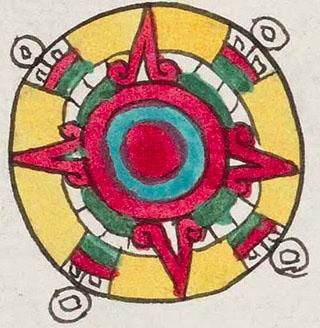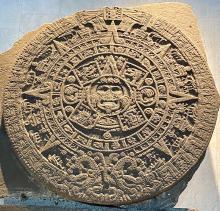Tonatiuhco (Mdz34r)
This simplex glyph for the place name Tonatiuhco refers to the sun, the tonatiuh. The locative suffix -co is not indicated visually. The tonatiuh is a circular symbol in multiple colors—yellow, red, turquoise, green, and white—with black lines to delineate the different components. Yellow predominates in the outer circular band, then concentric circles appear as we look from there toward the center, seeing first a band of sectioned white, then a circular band of green, then red, then turquoise, and finally a solid red center. There are four red points, evenly spaced, reaching from the middle red ring to the far edge of the outer yellow ring. These have almost an A shape (just missing the cross bar), with curls at the base, sitting on the red middle ring. The green ring is broken up by these red points. Also emanating from the middle white ring are four feather-like shapes (with the calumus marked, as Allison Caplan pointed out in a personal communication, 2022) that end with a round circle in white (with a small concentric circle) sitting on the outside of the yellow external ring.
Stephanie Wood
This glyph is the full version of the disk that is seen frequently as a half disk and equated with teotl), divine or sacred force(s). The full solar disk can also be read teotl and tlaca ("at midday"), according to Gordon Whittaker (Deciphering Aztec Hieroglyphs, 2021, 79). For more on the relationship between the teotl and tonatiuh glyphs, see Hansen and Helmke, New World Archaeology, 2019 (in our bibliography). They note that the half sun is usually the upper half, as we noticed independently. Only one of the half-sun examples of teotl from the Codex Mendoza is upside-down. (See below).
Also of note is the sign for ilhuitl, which has been seen in the Codex Mendoza to intend either day or month (even though month is metztli). The sign for ilhuitl appears on the front page of this project. It is circular and multi-colored, with four small circles on the perimeter, making it something of a quincunx (quadripartite, with a center), as well. Worth exploring are sun rays, temporal symbols, symbols of preciosity, the meaning of the colors, possible floral and feather elements, etc.
Our Online Nahuatl Dictionary cites the Florentine Codex reference to a "quetzal feather sun" (quetzaltonatiuh), which had a circle of quetzal feathers in the middle; this could possibly have some significance in the color choices in this glyph for tonatiuh. We also quote the Florentine Codex reference to, "the soaring eagle, the turquoise prince, the god," which could also be important for understanding the turquoise circular band in this glyph. Likewise, the Florentine Codex relates how women carried the sun on its descent in a litter covered with quetzal feathers.
Sun shapes are pervasive across Aztec and colonial Nahua visual culture, such as we see in these spindle whorls published by Mexicolore. Each of the four red points on this glyph from the Codex Mendoza, possibly doubling as sun rays, have a shape reminiscent of the A-O year sign in the Mixtec zone, if we were to extract the O. See, for example, the symbol as published by John Pohl in the FAMSI website. It is significant that these shapes in both the day/sun sign and the A-O year sign convey a calendrical significance. The four points connect to the cardinal directions; see also the four-pointed glyph for olin and the sun stone in the National Museum of Anthropology. The latter has what some see as a "double quincunx," as this glyph does. Page 1 of the Codex Fejérváry also has a double quincunx that is reminiscent of this sun sign. To these symbols James Maffie adds the glyph for olin, calling them "motion-change" symbols. (See his article, "Weaving the Aztec Cosmos: The Metaphysics of the 5th Era" in Mexicolore.) Nahui Olin (Four Movement or Four Earthquake) was the date of the start of the Fifth Sun (present era) in Aztec belief. Below, right, we include two examples of glyphs for the word tonal(li) (day), which also involve four small concentric circle sets. The glyphs for tezcatl, chalchihuitl, and xihuitl, also seen below, right, have these four sets of concentric circles around their perimeter. Given this coincidence and the meaning of these gems, the peripheral circles might have something to do with brilliance or shine.
Stephanie Wood
tonatiuhco. puo
Tonatiuhco, pueblo
Stephanie Wood
c. 1541, but by 1553 at the latest
Stephanie Wood
Joseph Scott and Crystal Boulton-Scott
suns, days, días, xiuhpohualli, año, turquesa, xihuitl, xiuhpohualli, turquesa, xihuitl, nombres de lugares
This stone carving of the sun (tonatiuh) is found in the National Museum of Anthropology and History. It was photographed by Rebecca Horn, 21 May 2023. Art history professor David Stuart has argued that this is a portrait of Montezuma II and refers to him as a “sun king.” [See: UT News, Feb. 22, 2018, https://news.utexas.edu/2018/02/22/new-interpretation-for-aztec-sun-ston... Political and religious, the stone is rich in calendrical and astronomical content and seemingly refers to historical events.

tonatiuh, sun or day, or sun deity, https://nahuatl.wired-humanities.org/content/tonatiuh
el sol
Alonso de Molina
Codex Mendoza, folio 34 recto, https://digital.bodleian.ox.ac.uk/objects/2fea788e-2aa2-4f08-b6d9-648c00..., image 78 of 188.
Original manuscript is held by the Bodleian Libraries, University of Oxford, MS. Arch. Selden. A. 1; used here with the UK Creative Commons, “Attribution-NonCommercial-ShareAlike 3.0 License” (CC-BY-NC-SA 3.0)



